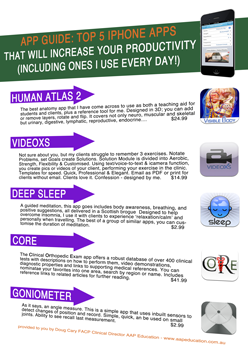Clinical Kit 96 - 21/10/2015- Vestibular Rehabilitation
Vestibular Rehabilitation - Part 1
I recently had the opportunity to attend a 5 day "Basic" course in vestibular rehabilitation that AAP Education was hosting in Melbourne and I must admit that I thought the commitment of 5 days was a bit over the top for the needs of a small rural and remote practice.
Most of you will know that I am a MSK physiotherapist with divergent interests in feet and dry needling and that my area of PhD research is exploring the association of spinal pain and sleep postures, so where would vestibular rehabilitation fit in?
Having attended, let me explain why I now believe this topic to be important. But first let me introduce the Vestibular Faculty.
From L to R (no titles included) are Jeff Hoder, Laura Morris, Jennifer Christy, Rick Clendaniel, Susan Herdman, Neil Shepard, Lisa Heusel-Gillig and at front Alec Ring. All except Alec are from the USA.
This course was started by Susan and has been taught for approximately 16 years. The USA presenters are specialists within the field of Vestibular Rehabilitation and in addition to teaching on the course have contributed chapters to the bible in this field; Vestibular Rehabilitation (more details here). Apart from being amazingly knowledgeable in this field, I can say that they are all very approachable people and very enthusiastic to educate practitioners about vestibular rehabilitation.
So this first Clinical Kit is to briefly summarize what was covered in the first few days (the manual is 2 inches thick of double sided A4 paper!) and emphasize one area of practical importance for MSK physiotherapists (as it is obviously important for neuro and geriatric focused physiotherapists).
The first day examined the anatomy and physiology of the vestibular system and related these to the critical elements of the clinical examination. The afternoon was then spent learning and practicing the clinical examination. We then spent time watching oculomotor videos. I found this section really important, as I had lots of examination 'pieces' but not really a coherent sequence that had meaning - test this, to check that, type of process. I can see that as I won't be practicing this examination on a daily basis, for me it will mean writing down a script, that will then be available to pull out and follow when clients present.
The next morning we looked at various other tests e.g. Caloric Tests, Rotatory Chair test, Electro-oculography and Video-oculography. Arguable not that relevant to a rural and remote physio, but like and MRI, having an understanding of what they are and being able to read and interrupt the report, will provide background information and specifically influence and guide rehabilitation pathways. Plenty of examples were provided which assisted the integration of this new information. A presentation on balance and gait looked at the ability to determine involvement of the three systems in balance (vestibular, somatosensory and visual). This lead into the afternoon session of clinical methods of assessing balance and gait. Relevant questionnaires were discussed and objective measures explained and then practiced.
One feature of this course that makes it different from others is the assessment process. Each practical module taught is then tested the next day. So you can't think 'my oculomotor examination is good', because you know you will need to demonstrate it. In the same way, all the balance and gait assessment tools, needed to be explained and demonstrated as part of your assessment. Definitely pushes you to absorb the high rate of information presented.
Tools that I found particularly handy from this session were;
- Dizziness Handicap Inventory (Dizzy clients will now complete this in the waiting room pre appointment)
- Modified Clinical Test for Sensory Interaction on Balance (quick method to evaluate 3 components of balance)
- Modified Timed Up & Go (87% sensitivity and specificity classifying potential fallers)
- Dynamic Gait Index (assesses ability to modify balance while walking in response to external demands)
- Functional Gait Index (similar to DGI, but higher ceiling level and more specific to younger vestibular clients)
If you want to see what a high level of balance integration looks like check this out.
We have started planning the return of this course in 2017. Details will be added to website as they become available.
Love to hear your thoughts and experiences.
Doug Cary FACP
Specialist Musculoskeletal Physiotherapist (awarded by Australian College of Physiotherapy, 2009)
PhD Candidate Curtin University
Clinical Director AAP Education
email: doug@aapeducation.com.au
ph/fx: 08 90715055
Receive a FREE Information Report
Choose The Top 5 Manual Therapy Apps or Infection Control & Needling (V3)
Along with the report you'll also get a complimentary subscription to "Clinical Kit" our regular eZine (email newsletter) and Free Bronze Membership. You'll get ideas, information, insight and inspiration on a regular basis, plus access to our Resource Library, helping you unravel those clinical conundrums appearing every day.
You are free to use material from the Blog in whole or in part, as long as you include complete attribution, including live website link. Please also notify me where the material will appear. The attribution should read: "By Doug Cary FACP of AAP Education. Please visit our website at www.aapeducation.com.au for additional clinical articles and resources on post graduate education for health professionals" (Please make sure the link is live if placed in an eZine or in a web site.)
HOME | DRY NEEDLING PROGRAM | CERVICAL SPINE | FASCIAL MANIPULATION | MULLIGANS | MSK & RT ULTRASOUND | NEURODYNAMIC SOLUTIONS | THE SHOULDER | VESTIBULAR PROGRAM | LIVING ANATOMY WET LABS | BLOG





